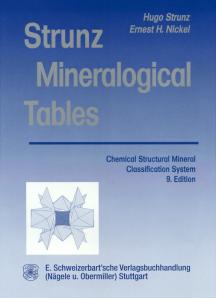 Hugo
Strunz; Ernest Nickel: Strunz Mineralogical Tables. Ninth Edition.
2001. 9th edition X, 870 pages, 262 figures, 24x17cm. ISBN 3-510-65188-X bound,
$158.00
Hugo
Strunz; Ernest Nickel: Strunz Mineralogical Tables. Ninth Edition.
2001. 9th edition X, 870 pages, 262 figures, 24x17cm. ISBN 3-510-65188-X bound,
$158.00
Mineralogical
Tables, first established as Mineralogische Tabellen by HUGO
STRUNZ in 1941, have gone through eight editions, numerous reprints and
translations.
This ninth, completely new English-language edition is fully revised and
updated and incorporates a large number of data on new minerals and new
data on previously described minerals.
Mineralogical Tables uses a chemical-structural mineral
classification system based on the same general principles as those
embodied in earlier editions:
All minerals are apportioned into one of ten classes according to their
principal anionic constituents.
Each of these ten classes is then broken down into divisions, subdivisions
and groups, based on chemical composition and crystal structure.
A simple alphanumeric coding system is applied to the various categories.
This coding system has intentional gaps that permit the insertion of new
categories of minerals yet to be discovered without disrupting the general
classification scheme.
The data are presented in tabular form, with minerals grouped by structure
type, and include the chemical formula and crystallographic parameters for
each mineral, as well as the authors and reference to the original mineral
description.
Literature references to reports of crystal structure determinations and
to the more recent descriptive papers are also provided. Each group is
accompanied by a brief description of the crystal structures of the
minerals comprising the group, and crystal-structure drawings are given
for many of the important structure types.
Audience: Mineralogists, Earth Scientists, serious mineral collectors
Contents: Introduction Historical Development 1 Chemical Bonding and Crystal Structures 7 Definitions 13 The Data in the Tabulations 14 The Classification System 14 Summary of System 17 Periodicals 28 1. ELEMENTS (Metals and intermetallic alloys; metalloids and nonmetals; carbides, silicides, nitrides, phosphides) 1.A: Metals and Intermetallic Alloys 33 1.B: Metallic Carbides, Silicides, Nitrides and Phosphides 46 1.C: Metalloids and Nonmetals 50 1.D: Nonmetallic Carbides and Nitrides 54 2. SULFIDES and SULFOSALTS (sulfides, selenides, tellurides; arsenides, antimonides, bismuthides; sulfarsenites, sulfantimonites, sulfbismuthites, etc.) Sulfides, etc. 2.A: Metal/metalloid alloys 56 2.B: Metal Sulfides, M: S > 1: 1 (mainly 2: 1) 61 2.C: Metal Sulfides, M: S = 1: 1 (and similar) 75 2.D: Metal Sulfides, M: S = 3 :4 and 2:3 93 2.E: Metal Sulfides, M: S <= 1:2 100 2.F: Sulfides of arsenic, alkalies; sulfides with halide, oxide, hydroxide, H2O 110 Sulfosalts 2.G: Sulfarsenites, sulfantimonites, sulfbismuthites 118 2.H: Sulfosalts of SnS archetype 128 2.J: Sulfosalts of PbS archetype 140 2.K: Sulfarsenates 147 3. HALIDES 3.A: Simple halides, without H2O 148 3.B: Simple halides, with H2O 155 3.C: Complex halides 159 3.D: Oxyhalides, hydroxyhalides and related double halides 170 4. OXIDES (Hydroxides, V[5,6] vanadates, arsenites, antimonites, bismuthites, sulfites, selenites, tellurites, iodates) 4.A: Metal: 0xygen = 2:1 and 1:1 182 4.B: Metal: Oxygen = 3:4 and similar 187 4.C: Metal: 0xygen = 2: 3,3: 5, and similar 192 4.D: Metal: Oxygen = 1:2 and similar 203 4.E: Metal: 0xygen = < 1 :2 229 4.F: Hydroxides (without V or U) 230 4.G: Uranyl Hydroxides 248 4.H: V[5,6] Vanadates 254 4.J: Arsenites, antimonites, bismuthites, sulfites, selenites, tellurites; iodates 262 4.K: Iodates 281 5. CARBONATES (+ NITRATES) 5.A: Carbonates without additional anions, without H2O 284 5.B: Carbonates with additional anions, without H2O 292 5.C: Carbonates without additional anions, with H2O 303 5.D: Carbonates with additional anions, with H2O 309 5.E: Uranyl Carbonates 318 5.N: NITRATES 324 6. BORATES 6.A: Monoborates 328 6.B: Diborates 338 6.C: Triborates 341 6.D: Tetraborates 345 6.E: Pentaborates 349 6.F: Hexaborates 354 6.G: Heptaborates and other megaborates 358 6.H: Unclassified borates 361 7. SULFATES (selenates, tellurates, chromates, molybdates, wolframates) 7.A: Sulfates (selenates, etc.) without additional anions, without H2O 363 7.B: Sulfates (selenates, etc.) with additional anions, without H2O 370 7.C: Sulfates (selenates, etc.) without additional anions, with H2O 379 7.D: Sulfates (selenates, etc.) with additional anions, with H2O 395 7.E: Uranyl sulfates 413 7.F: Chromates 415 7.G: Molybdates end wolframates 418 7.H: Uranium and uranyl molybdates and wolframates 422 8. PHOSPHATES, ARSENATES, VANADATES 8.A: Phosphates, etc. without additional anions, without H2O 424 8.B: Phosphates, etc., with additional anions, without H2O 439 8.C: Phosphates without additional anions, with H2O 470 8.D: Phosphates, etc. with additional anions, with H2O 491 8.E: Uranyl phosphates and arsenates 521 8.F: Polyphosphates, Polyarsenates, [4]-Polyvanadates 530 9. SILICATES (Germanates) 9.A: Nesosilicates 534 9.B: Sorosilicates 567 9.C: Cyclosilicates 594 9.D: Inosilicates 617 9.E: Phyllosilicates 657 9.F: Tektosilicates without zeolitic H2O 691 9.G: Tektosilicates with zeolitic H2O; zeolite family 701 9.H: Unclassified silicates 712 9.J: Germanates 716 10. ORGANIC COMPOUNDS 10.A: Salts of organic acids 717 10.B: Hydrocarbons 722 10.C: Miscellaneous Organic Minerals 724 Appendix (New minerals, structures, reclassification) 727 Alphabetic index of mineral names 737